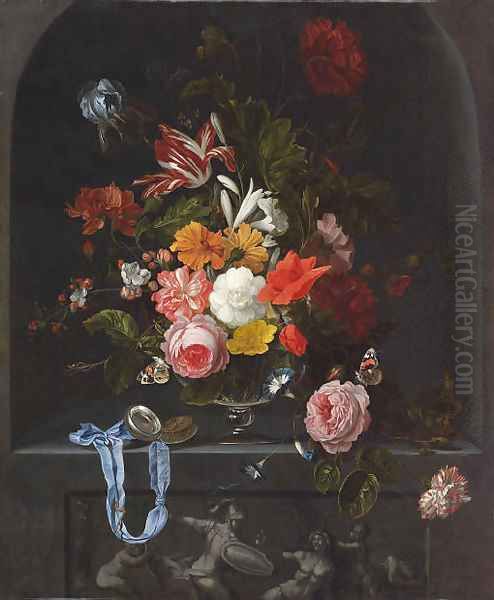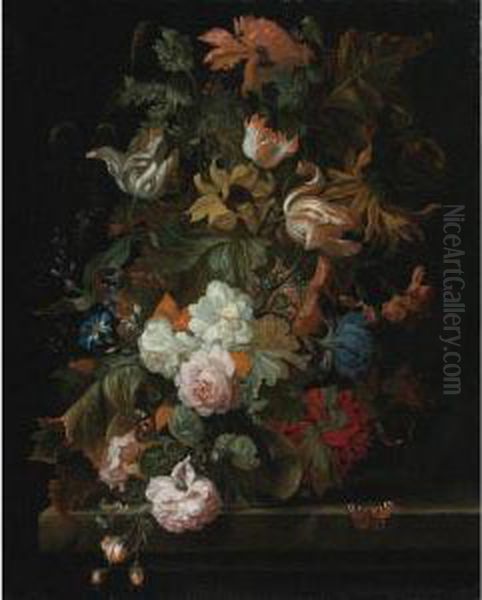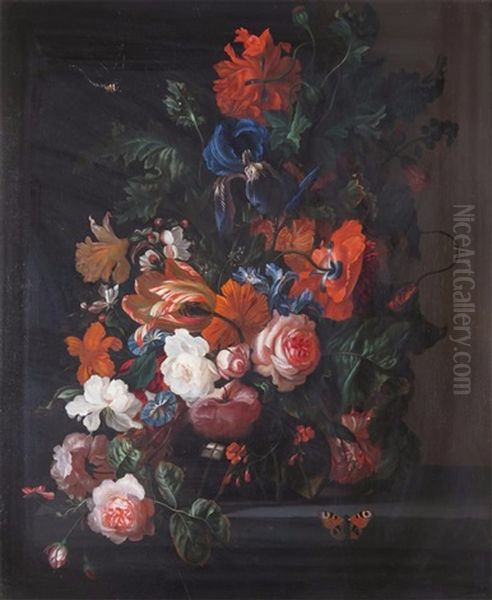Ernst Stuven, a notable painter of the Dutch Golden Age, carved a significant niche for himself through his exquisite still life compositions, particularly those featuring flowers and fruits. Though perhaps not as universally recognized today as some of his contemporaries, Stuven's artistry contributed to the rich tapestry of 17th and early 18th-century Dutch painting, a period renowned for its mastery of realism and symbolic depth in still life. His life and work offer a fascinating glimpse into the artistic environment of Amsterdam and Rotterdam, the training of painters, and the enduring appeal of nature's bounty as an artistic subject.
Early Life and Artistic Genesis
Born in Hamburg in 1657, Ernst Stuven's artistic journey would lead him to the heart of the Dutch art world. The precise details of his earliest years in Hamburg are not extensively documented, but it is known that his artistic inclinations drew him to the Netherlands, which was then the epicenter of still life painting. Around 1675, at the age of approximately eighteen, Stuven made the pivotal move to Amsterdam, a bustling metropolis teeming with artistic talent and patronage.
In Amsterdam, Stuven sought out the best possible training to hone his skills. He initially became a pupil of Jan Voorhout, a painter known for historical and genre scenes. While Voorhout's primary subjects differed from Stuven's eventual specialization, this early instruction would have provided a foundational understanding of composition, color, and technique. However, to truly master the art of still life, particularly floral painting, Stuven needed more specialized guidance.
Apprenticeship under Masters of Still Life
Recognizing his passion, Stuven subsequently apprenticed with two of the leading still life painters of the era: Willem van Aelst and Abraham Mignon. This period of study was crucial in shaping his artistic style and technical proficiency.

Willem van Aelst, renowned for his elegant and refined still lifes of flowers, fruit, and game, would have imparted to Stuven a sense of sophisticated composition and a keen eye for luxurious textures. Van Aelst's works often featured asymmetrical arrangements, rich colors, and a delicate rendering of light, characteristics that Stuven would absorb and adapt. Van Aelst himself had spent time in France and Italy, bringing a certain courtly elegance to Dutch still life, which likely influenced Stuven's appreciation for refined aesthetics.
Abraham Mignon, another German-born painter who found success in the Netherlands, was Stuven's other significant mentor. Mignon was celebrated for his lush, detailed, and often densely packed floral arrangements, frequently set against dark backgrounds that made the vibrant colors of the blooms pop. He was also known for incorporating insects, small animals, and elements of the forest floor into his compositions, adding layers of naturalistic detail and symbolic meaning. Stuven's meticulous attention to detail and his ability to render a profusion of flora can be seen as a continuation of Mignon's influence. Mignon, in turn, had been a student of Jan Davidsz. de Heem, one of the most influential still life painters of the 17th century, thus connecting Stuven to a distinguished lineage of Dutch still life artists.
Life in Amsterdam and Artistic Connections
During his time in Amsterdam, Ernst Stuven became part of a vibrant artistic community. He resided for a period on the Bloemengracht, or "Flower Canal," an aptly named location for a painter specializing in floral subjects. This area was known to be a hub for artists and artisans. Significantly, Stuven lived with the family of Rachel Ruysch, one of the most celebrated female painters of the Dutch Golden Age, herself a master of flower still lifes.
Rachel Ruysch, daughter of the renowned botanist and anatomist Frederik Ruysch, had an unparalleled ability to depict flowers with scientific accuracy and artistic flair. Living in such close proximity to an artist of Ruysch's caliber, and possibly alongside her husband, the portrait painter Juriaen Pool, would have provided Stuven with an immersive artistic environment. The daily exchange of ideas, observation of techniques, and shared passion for floral subjects undoubtedly contributed to his development. It's plausible that Stuven and Ruysch influenced each other, or at the very least, that Stuven benefited immensely from observing her meticulous approach and dynamic compositions.

Stuven's artistic connections also extended to Willem Kalf, a towering figure in Dutch still life painting, known for his opulent pronkstilleven (ostentatious still lifes). While not explicitly listed as a direct teacher in the same vein as Van Aelst or Mignon, the provided information notes an "artistic connection" to Kalf. This could imply shared artistic circles, mutual admiration, or an influence of Kalf's mastery of texture, light, and luxurious subject matter on Stuven's own approach to depicting the richness of fruits and the sheen of vessels. Kalf's ability to render reflective surfaces like silver and glass was unparalleled, and any association with him would have been artistically enriching.
Artistic Style and Thematic Focus
Ernst Stuven's oeuvre is characterized by his dedication to capturing the beauty and transience of nature. His primary subjects were arrangements of flowers and fruits, often depicted with a high degree of realism and attention to detail. His style reflects the training he received, blending the elegance of Van Aelst with the detailed richness of Mignon.
His floral compositions typically feature a variety of blooms, showcasing different species, colors, and stages of life – from fresh buds to fully opened flowers, and sometimes even slightly wilting ones, subtly hinting at the vanitas theme common in Dutch still life. This theme reminded viewers of the fleeting nature of life and earthly beauty. The flowers are often arranged in glass vases or on stone ledges, allowing Stuven to demonstrate his skill in rendering different textures.
In his fruit still lifes, Stuven depicted succulent grapes, peaches, plums, and other fruits, often accompanied by foliage and insects. The play of light on the dewy surfaces of the fruit, the intricate details of leaves, and the presence of butterflies or caterpillars added to the naturalism and symbolic complexity of his works. These insects were not mere decorative elements; they could symbolize transformation, decay, or the soul.
Stuven's compositions, while often lush, maintained a sense of balance. He employed a rich color palette, skillfully contrasting light and dark to create depth and drama, a technique known as chiaroscuro, which was a hallmark of Baroque painting. His brushwork was generally fine and controlled, allowing for the precise rendering of botanical details.
Representative Works
Among Ernst Stuven's known works, several stand out and are housed in prestigious collections, attesting to his skill and recognition.

One such painting is "Flowers and Fruit," an oil on canvas measuring 30 7/8 x 25 1/8 inches, currently in the collection of the Metropolitan Museum of Art in New York. This work likely showcases his characteristic combination of vibrant floral arrangements with luscious fruits, demonstrating his ability to handle diverse textures and forms within a single composition. Such paintings would have appealed to the wealthy merchant class of the Netherlands, who adorned their homes with art that celebrated both nature's beauty and the owner's sophisticated taste.
Another significant piece is "Flowers in a glass vase," an oil painting measuring 85.5 x 67.5 cm, held by the Gemäldegalerie Alte Meister in Dresden. This painting would exemplify his mastery in depicting flowers with botanical accuracy, likely featuring a variety of species artfully arranged. The choice of a glass vase was common, as it allowed the artist to showcase their skill in rendering transparency and reflections, with the stems visible through the water. The Dresden gallery is renowned for its collection of Old Masters, and Stuven's inclusion there underscores his importance.
These works, and others attributed to him, highlight Stuven's contribution to the still life genre. They are a testament to his meticulous observation, his technical skill in rendering textures and light, and his ability to create compositions that were both aesthetically pleasing and rich in potential meaning.
Teaching and Influence on Later Artists
Beyond his own artistic output, Ernst Stuven played a role in educating the next generation of painters. He is recorded as having taught several students, thereby passing on the traditions and techniques he had learned from his own masters.
One of his notable pupils was Herman van der Myn (or Mÿn). Van der Myn initially learned flower painting from Stuven. He later expanded his repertoire and achieved considerable success. In 1712, the year of Stuven's death, Herman van der Myn became a master in the Guild of Saint Luke in Antwerp. His talents eventually led him to become a court painter to Johann Wilhelm, the Elector Palatine, a significant patron of the arts. Van der Myn's career, which also took him to London, demonstrates the quality of instruction he received from Stuven.

Another student of Stuven was Jan van Nickelen. Like his master, Jan van Nickelen specialized in flower painting. He, in turn, continued the tradition of artistic instruction by teaching his own daughter, Jacob Maria van Nickelen, the art of painting flowers. Jacob Maria van Nickelen later married the painter Willem Ruysirs (this name might be a variation or a distinct individual from Willem Troost, Rachel Ruysch's husband, though the similarity is noted). This lineage of teaching, from Stuven to Jan van Nickelen to Jacob Maria van Nickelen, illustrates how artistic skills and specializations were often passed down through direct mentorship, sometimes within families.
The impact of a teacher like Stuven extends beyond the direct replication of style. He would have instilled in his students a disciplined approach to observation, a mastery of materials, and an understanding of composition, allowing them to develop their own artistic voices while building on a solid foundation.
Contemporaries and the Broader Artistic Context
Stuven worked during a period of incredible artistic production in the Netherlands. The demand for paintings was high, and still life was a particularly popular genre. He was a contemporary of many other skilled still life painters. Besides his teachers Van Aelst and Mignon, and his associate Rachel Ruysch, other prominent figures in flower painting included Maria van Oosterwijck, another highly successful female artist known for her detailed and richly colored floral pieces, and Simon Verelst, whose flower paintings were also highly sought after, particularly in England.
The broader field of still life also included masters like Juriaen van Streeck, who painted sumptuous banquet pieces and fruit still lifes, often with a similar attention to texture and light as Stuven. The legacy of earlier pioneers like Ambrosius Bosschaert the Elder and Balthasar van der Ast, who established flower painting as a distinct genre in the early 17th century, still resonated. Their detailed, often symmetrical arrangements laid the groundwork for later developments.
Painters like Otto Marseus van Schrieck, known for his sottobosco (forest floor) still lifes featuring fungi, reptiles, and insects in dark, mysterious settings, represented another facet of still life that sometimes overlapped with the detailed naturalism found in the work of Mignon and, by extension, Stuven. The scientific curiosity of the age, fueled by global exploration and the collection of exotic flora and fauna, also played a role in the popularity and detailed nature of these paintings.
Later Years and Death
While much of his formative and active career was spent in Amsterdam, Ernst Stuven later moved to Rotterdam. The reasons for this move are not clearly documented but could have been related to patronage opportunities or personal circumstances. He continued to paint, contributing to Rotterdam's artistic life.
Ernst Stuven passed away in Rotterdam in 1712, at the age of approximately 55. His death marked the end of a career dedicated to the meticulous and beautiful depiction of the natural world.
Legacy and Conclusion
Ernst Stuven's legacy lies in his contribution to the rich tradition of Dutch still life painting. While he may not have achieved the same level of fame as a Rembrandt or Vermeer, or even the very top tier of still life specialists like Willem Kalf or Rachel Ruysch, his work is a testament to the high level of skill and artistry prevalent in the Dutch Golden Age.
He successfully absorbed the teachings of his masters, Willem van Aelst and Abraham Mignon, and developed a style that combined elegance with detailed realism. His depictions of flowers and fruits are characterized by their vibrant colors, careful composition, and meticulous rendering of textures. Through his paintings, Stuven invited viewers to appreciate the intricate beauty of the natural world, while often subtly alluding to deeper themes of transience and the preciousness of life.
His role as a teacher, particularly to artists like Herman van der Myn and Jan van Nickelen, ensured that his knowledge and artistic approach were passed on, contributing to the continuity of the still life tradition. The fact that his works are found in major museum collections today, such as the Metropolitan Museum of Art and the Gemäldegalerie Alte Meister, affirms their lasting quality and historical importance.
Ernst Stuven remains a significant figure for those who study Dutch Golden Age art, representing the dedication, skill, and specialized focus that characterized many painters of his era. His art continues to offer a window into a time when the humble flower or a bowl of fruit could be transformed, through the painter's skill, into an object of profound beauty and contemplation. His life, spanning Hamburg, Amsterdam, and Rotterdam, and his connections with some of the leading artists of his day, paint a picture of a dedicated artist fully immersed in the vibrant cultural milieu of 17th and early 18th-century Northern Europe.